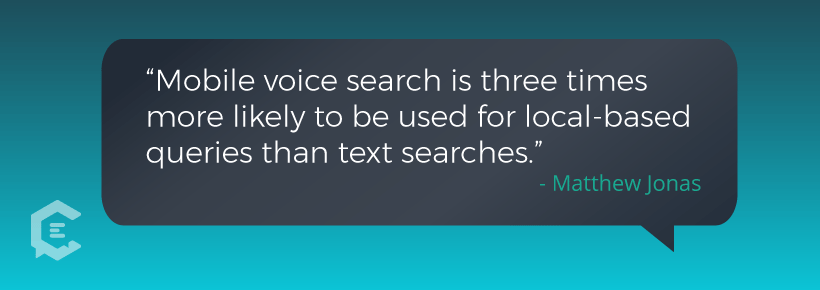Siri, Alexa, and Google are household names now. These voice assistants and the compact devices that house their digital components are practically omnipresent, and their convenient help is becoming indispensable to many consumers.
According to Gartner, Inc., by the year 2020, 30% of consumer browsing sessions will likely take place using voice-activated technology, whether it’s with a smartphone or with a device like the Echo or the Google Home.
So how can you begin to make use of voice-powered technology for your content marketing? How can you optimize your content, not just for regular typed text searches, but for the new world of voice search? Discover six different ways that you could leverage voice platforms for your business’s content marketing.
Better content marketing strategies for smart speakers
1. Determine your demographic’s interest level
Before you get too excited about leveraging voice-activated content, take some time to figure out if your consumers actually use the Echo, Google Home, or HomePod. A poll or survey can inform you about how your target demographic uses voice-activated technology, and how often they use it.
If you discover that most of your customers are chummy with their preferred voice assistant, perhaps you can dig a little deeper to find out how they use it. What pain points do they soothe with these devices? What questions do they ask every day? How do the devices make their lives easier? Once you have data related to those important points, you can begin to develop some content marketing strategies that will actually be meaningful for your customers.
2. Use Alexa Flash Briefings for daily connection
Have you heard about Flash Briefings? It’s a new skill under Settings in the Alexa app. Users can set up Alexa to give them a quick bit of information, such as an update from a blog feed, a daily joke, an interview, or a news item. Just as a user might get into the habit of saying, “Alexa, tell me the news” every morning, so will he or she automatically begin the day with, “Alexa, give me my Flash Briefing.” Hopefully, that briefing will include a pithy dose of daily content from your company.
In order to make this happen, you’re going to need to offer some new content every day. It doesn’t need to be long — in fact, it should bite-sized. Designing a new Amazon Alexa skill can sound frightening, and to the uninitiated, it can be a daunting process. However, it really isn’t too bad and requires no software engineering skills. Be sure to check back for next week’s #MartechMonday post and I’ll provide a full guide on setting this up.
3. Create exclusive content linked to print or online pieces
In August 2017, Google and Vogue linked arms to bring exclusive content to Google Home, Google’s rival to the Amazon Echo. According to AdWeek, Vogue’s writers developed some voice content to accompany the stories included in the print magazine. To access the special content, Google Homeowners could say, “OK Google, ask Vogue to tell me more about Jennifer Lawrence.” Google Home would then play a bit of audio from Jason Gay, the writer who actually interviewed Lawrence for Vogue’s cover story in the September 2017 issue. Other questions unlocked audio pieces about more feature articles in the issue.
You can leverage voice-activated technology in similar ways. Do you publish an email newsletter, a printed piece for direct mail, or a regular blog? Create some unique content just for customers who own an Amazon Echo, Google Home, or HomePod. Those users will enjoy using the special questions to access exclusive bits of information, secret discount codes, or hot news items.
4. Leverage Apple’s HomePod to reach music enthusiasts
Apple just launched the HomePod on February 9, 2018. The device is crammed with audio power, designed to create an amazing listening experience in spite of its small size; and the unit delivers, with beautiful, clear sound even at high volume. It’s positioned to be the number one choice for customers whose main purpose for the device is to listen to great music conveniently throughout their home.
Why not create some audio ads for Spotify, Pandora, or another music streaming service? According to a recent report, 68% of smart speaker owners are using their devices to listen to music. With so many people tuning in to those streaming stations, you’ll have access to an entire segment of new customers.
5. Advertise on a podcast or start your own
There’s still room for podcasts in the digital world; in fact, some believe that podcasts are even better than blogs when it comes to creating meaningful customer engagement and building brand loyalty. Not everyone listens to podcasts, but if your target demographic tends to tune in to them frequently, consider creating one for your business. You’ll need an excellent podcaster to run the show, and you’ll need valuable, interesting content, with a little humor thrown in. But according to Forbes, that initial effort could pay off big-time.
Peter Horst, Forbes contributor, cited an IAB study in his recent article on marketing and voice assistants. The study reveals that “65% of podcast listeners are more likely to purchase a product they learned about from a podcast. The study also showed that all things being equal, 60% of consumers would rather purchase a brand that advertised on their favorite podcasts.”
Creating a content-rich, intelligent, fascinating podcast could yield powerful results with your customers — provided that they’re into podcasts in the first place. They would then be able to access your company’s podcast anytime through their favorite home device like the Google Home, the Amazon Echo, or HomePod. If you don’t want to start your own, investigate which podcasts your target customers favor, and find out how to advertise on those existing podcasts.
6. Optimize content for smart speaker searches
Since this market is so new, it’s difficult to identify any specific rules for optimizing your content so that Alexa, Google, or Siri can find it. However, research indicates that FAQ-style content, articles, local information, and longtail keywords get top billing when it comes to being selected for use on the smart speakers.
When people are speaking to their voice assistants, they typically use questions or short phrases, like “What’s the weather?” or “antique shops near Sunset Park” or “Who’s in the cast of the ‘Red Sparrow’ movie?” They might also ask about local offerings like farmer’s markets, town events, repair services, or landscaping companies. Try to incorporate similar phrases or questions throughout your company’s content, to gain the attention of the smart assistants.
According to a recent Forbes post by Matthew Jonas, “mobile voice search is three times more likely to be used for local-based queries than text searches.” Doing locally based SEO can be a lot more complex than general SEO, but if you can find a way to accomplish it, you’ll see significantly higher success in the realm of voice-activated search. Try using local voices and local knowledge in your content, and put the name, address, and phone number of your business on every page of web content you produce.
Pulling it all together
Are you ready to begin leveraging voice-activated platforms for your content marketing? Start by gauging customer interest and finding those pain points. Embed FAQ-style questions and local references within your content, and advertise with a music streaming service or podcast that’s popular with your demographic. Plus, don’t forget to leverage the creativity and ideas of your own content marketing team. Together, you just might discover a brand-new way to do genius content marketing on the new generation of smart speakers.







